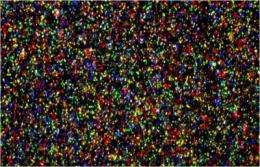For the first time, scientists discover causative gene of a rare disorder by exome sequencing

(PhysOrg.com) -- UW researchers have successfully used a method called exome sequencing to quickly discover a previously unknown gene responsible for a rare disorder. The finding demonstrates the usefulness of exome sequencing in studying the 7,000 plus rare genetic disorders affecting millions of people.
For the first time, scientists have successfully used a method called exome sequencing to quickly discover a previously unknown gene responsible for a mendelian disorder.
Mendelian disorders, such as cystic fibrosis and sickle cell disease, are the result of one or more mutations in a single gene, typically a gene that makes a protein. All of the regions that code for proteins taken together are called the exome. The exome makes up about 1 percent of the genome, but it is in this 1 percent that more than 85 percent of mutations that cause mendelian disorders are found. That is why sequencing the exome is an efficient strategy to search for genes that underlie rare genetic disorders.
The study, "Exome sequencing identifies the cause of a mendelian disorder," was led by University of Washington (UW) researchers and published today, Nov. 13, in Nature Genetics.
While most mendelian disorders are rare, there are 7,000-plus suspected mendelian disorders that in aggregate affect millions of people in the United States, according to Dr. Michael J. Bamshad, one of the senior authors of the study, a UW professor of genome sciences and pediatrics, and a pediatrician at Seattle Children's. "Our results show that scientists could use exome sequencing to identify the genetic cause for thousands of disorders for which the gene hasn't been discovered."
"One of the reasons that this strategy is so powerful is that the scientists need only use a small number of unrelated cases to find the gene," said the other senior author of the study, Dr. Jay Shendure, UW assistant professor of genome sciences.
The disorder the UW research team used to test the strategy is Miller syndrome, whose genetic cause had been impossible to determine through conventional approaches. People with this syndrome have a number of malformations affecting their mouths, eyelids, ears, and feet. The research team was able to find that mutations in the gene, DHODH, cause Miller syndrome.
"Identifying the genetic basis of rare, single-gene diseases is of substantial interest to medical scientists," said Sarah Ng, a UW genome sciences graduate student and co-first author of the study, "because it provides important knowledge about disease mechanisms, biological pathways, and potential targets for therapies."
"Once we discover the causative gene," she added, "we can begin to look at how the gene might lead to the development of disease and what factors predict the outcome."
After scientists identify one causative gene and its repercussions, by extension they might discover other genes or environmental agents that affect the same biological pathway. For example, the malformation patterns found in Miller syndrome are similar to the birth defects in fetuses of some, but not all, mothers who took the drug methotrexate during pregnancy. Knowing this might provide some clues to genetic susceptibility to birth defects from methotrexate.
The ability of exome sequencing to identify a causative gene in a few months, compared to earlier methods that took years, "caused an audible gasp in the audience when we presented these findings to our peers," Bamshad said. "The power of this strategy is remarkable to many of us."
"We hope that the results of this study help point the way for thousands of scientists working on rare disorders who are seeking more efficient ways to locate the causative gene," Shendure added. "The exome sequencing strategy may also prove useful in studies of common disorders with complex genetics."
The study published this week in Nature Genetics was a collaborative effort among scientists from many disciplines and institutions.
Provided by University of Washington (news : web)















